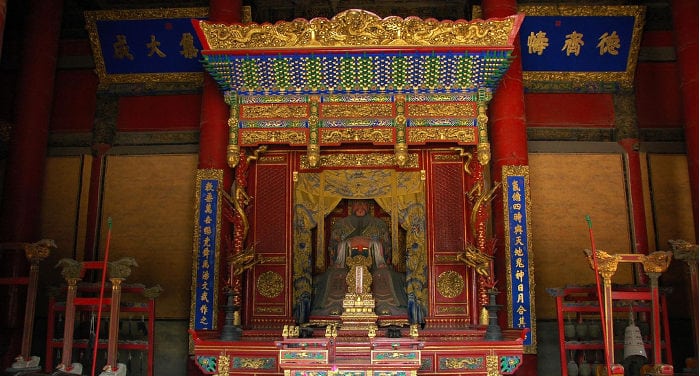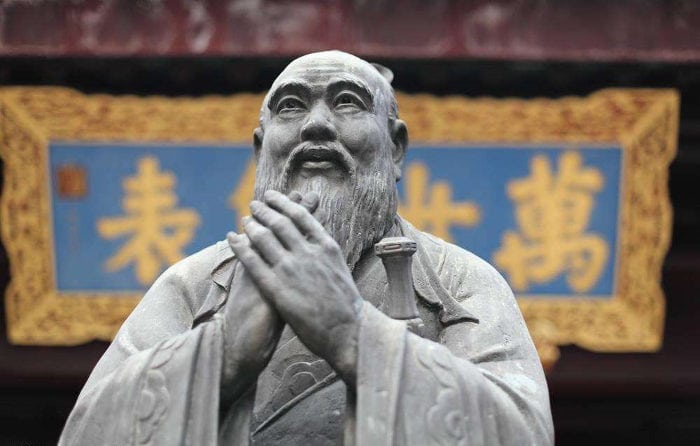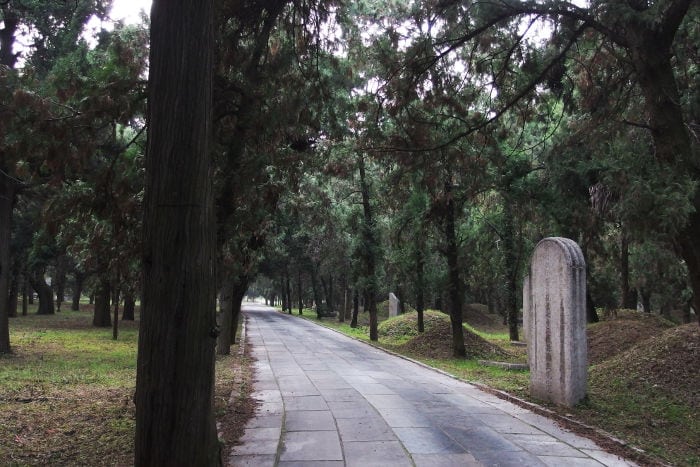
One of Confucius’ most famous phrases, in the first of his dialogues (论语) is:
“A friend who comes to visit from afar, is it not a joy?”
And so despite the fact that Qufu is a small city in the interior of Shandong, those traveling in the region have to visit Confucius’ good friend.
In China, Qufu is considered a small to mid-size city, with “only” about six hundred thousand inhabitants. It is located in the western part of Shandong, far from the region’s coast, where you can find the main cities of (Qingdao and Yantai), and south of the region’s capital Jinan.
For those traveling in Shandong it is however convenient to reach Qufu: not far from the city center there is in fact a high speed train station Qufu East (曲阜东), where trains arrive from the major cities.
Who is Confucius (or Kongzi)?
Confucius, the most important and well-known Chinese philosopher, was born in Qufu in 551 B.C., and stayed there until his death in 479 B.C. Founder of the Confucian school during the period of warring states, his writings and teachings have become an important part of the culture, history and daily life of the Chinese people beginning with the Han Dynasty (202 a.c).
Confucius’ Chinese name is Kongzi (孔子). The surname Kong was typical of the Lu state (鲁), which corresponds to modern day Shandong, and the Kongs were one of the most important families of the city of Qufu. In fact you’ll find that in the majority of sites of interest dedicated to Confucius there’s evidence of the reconstruction of the genealogical lineage of the Kongs of Qufu.

Visiting Qufu
To visit Qufu one day is sufficient. Even today the city has preserved the characteristics of a typical Chinese city, surrounded by a wall, with a little canal to delineate the perimeter, low buildings, imposing gates that mark the entrance to the old city and the presence of a drum tower.
If you come to Qufu from Beijing, Shanghai or the major cities of Shandong, you’ll arrive at the Qufu East Railway Station (曲阜东站). The station is located about an hour from the old city, and to get to the Temple of Confucius(孔庙, where I’d recommend that you start your visit, you can take a taxi, it will cost about 30 Yuan, or bus K01, the cheaper option since a ticket costs only one Yuan.
If you choose the bus I recommend that you ask where the stop is, since it isn’t easy to find (you need to go back into the station and then leave from the east side).
If you’re in Qufu on foot, and don’t intend to bring your backpack and baggage with you, I recommend that you go to the supermarket to the right of the station exit, you’ll see in large characters 超市. There they have a baggage storage service for 20 Yuan for the whole day; don’t pay attention to the offerings inside the supermarket (organized tours or private buses), the prices are excessive.
The Three Kongs (三孔)
Once at the Temple of Confucius, you’ll find the ticket counter at the long tree-lined drive outside the main entrance. I suggest you buy a ticket for the Three Kongs, which includes the temple, the house and the Confucius Temple. A ticket costs 150 Yuan (discounted for kids, the elderly and students to 75), and includes a visit just for these three attractions.
If on some site you read that the ticket for the Three Kongs also includes a visit to the other Temples of Qufu, such as Yanhui Temple (颜庙) or a small temple dedicated to Confucius outside the forest, don’t believe it since it is absolutely not true.
The Temple of Confucius (孔庙)
The Temple of Confucius is a complex of imperial buildings, commemorative arches and ritual rooms; it’s the biggest in China after Beijing’s Forbidden City.
When Confucius was alive the temple was a home for the master and his disciples, and after his death in 479 B.C., the duke of Lu state decided to make the master’s residence a temple. In it’s two thousand five hundred years of history, the temple has been enlarged, destroyed and rebuilt, and what we see today goes back to 1499, during the Ming Dynasty.
After entering the temple you’ll find a series of arches and gates, built by various emperors to pay homage to Confucius, almost all built during the Ming Dynasty, On the arches and gates there are the writings and teachings of Confucius.
I suggest that you buy a little blue book at the entrance of the temple which explains in detail information about the buildings you’ll find in the temple, with an excellent English translation.
Continuing the visit, you’ll arrive at the apricot altar. Even though the famous apricot tree where legend has it that Confucius taught his lessons each day to his 72 disciples is no longer there, you’ll find a beautiful enclosed altar to commemorate the spot.
Continuing the visit, walking between the many junipers, and before the exit you’ll find the main ritual room, the room dedicated to Confucius’ wife, and at the bottom of the temple, two beautiful gardens.
Once done visiting the Temple of Confucius, head toward the second Kong, Confucius’ house (孔府). The road that connects the exit of the temple to the entrance to the house is full of little stalls; if you need to buy a gift or souvenir, stop here for little statues of Confucius to books of his dialogues, you can buy everything having to do with the master.
The House of Confucius (孔府)
As was already said, during his life Confucius lived inside the temple, along with his son and grandson. Beginning with his great grandson, since the lineage of the Kong was enlarged and by now the city enjoyed a certain amount of fame, next to the Temple of Confucius they put up the residence for the descendants of the philosopher.
Today the residence of Confucius is a city within a city. Itself circled by a low stone wall, it is a labyrinth composed of about 150 buildings and almost 500 halls, losing yourself in the magnificent maze of alleys there’s no shortage of surprises. In fact there are tons of prayer halls where you can see altars and paintings on the walls, rooms reserved for family reunions and buildings where they practice artistic disciplines such as music and calligraphy.
Don’t underestimate the western wing of the house, where there are less tourists. Here, despite the buildings being almost the same and rather bare inside, you’ll find a gorgeous photo display of the city of Qufu beginning in the 1900’s, pictures of the city’s main attractions and a few taken of the presumed descendants of Confucius.

Confucius’ Forest (孔林)
The third and last of the three Kong’s is Confucius’ Forest, also known as Confucius’ Mausoleum. It is in fact here that you’ll find the philosopher’s tomb. Confucius’ Forest is situated outside the walls of the city. Getting there is simple: leaving the house of Confucius just keep going straight along Gulou North Road (鼓楼北街). After a half hour of walking you’ll arrive at the entrance of the forest.
Keep in mind that inside the forest there’s not only Confucius’ Mausoleum, but many Ming tombs marked by statues or slabs of stone with remarkable carvings. So in order to see the forest well you’ll need more than two hours.
Since it closes at five, if you think you won’t make it I recommend that you take the little train in front of the ticket office. The little train costs 20 Yuan and stops near site of greater interest. The only problem is that you can’t get off other than when visiting Confucius’ Mausoleum.
In the mausoleum, besides the wise man’s tomb, there are also those of his son and grandson. The tombs aren’t anything extravagant, they’re just simple mounds covered by grass. The master’s is marked by a stele going back to the Ming era and is watched over by two stone guardians.
The end of the visit
Once done with your visit remember that the baggage storage at the station closes at 21, and getting to the station takes an hour. If you have time I recommend that you walk around the city where you’ll find interesting and characteristic roads.
If instead you want to spend the night in Qufu, once you get out of the forest turn back on Gulou North Road, and in front of Yanhui Temple (颜庙) you’ll find a welcoming youth hostel (曲阜青年旅舍).



